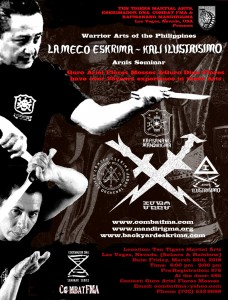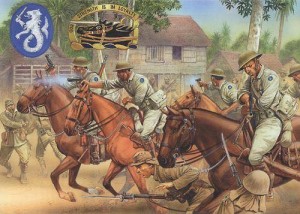
Seminar: Lameco SOG Eskrima and Kali Ilustrisimo with Guro Ariel Flores Mosses and Guro Dino Flores. Las Vegas, Nevada. March 23rd, 2018. Guro Dino and Guro Ariel have been training partners since the 1980′s. They first began teaching seminars together in the 1990′s in Wahington State, Oregon, Nevada and California. About Guro Ariel: Traditional Arts for a Modern World!Master Ariel F. Mosses has over 30 years of Filipino Martial Arts experience. He has trained under the watchful eyes and close supervision of three legendary Grandmasters: Filipino Martial Arts Hall of Fame Grandmaster Conrad A. Manaois, the late Grandmaster Christopher “Topher” Ricketts of Kali Ilustrisimo, and the late Punong Guro Edgar G. Sulite, founder of Lameco Eskrima International.Master Ariel F. Mosses is the Vice President and Chief Instructor for Manaois Systems International. Master Mosses holds an 8th degree black belt in Kali Jukune Do, as well as an 8th level Master Instructor in Manaois Eskrima.He is an authorized Senior Instructor in Lameco S.O.G., and an authorized Senior Instructor in Kali Ilustrisimo C.N.R. Master Mosses is enshrined in the Filipino Martial Arts Hall of Fame, and is a proud member of Kapisanang Mandirigma, a Federation of warriors from different disciplines of the Warrior Arts of the Philippines.Master Mosses is a certified Nevada CCW instructor.Trained by LEGENDS of Filipino CombatThe Filipino Warrior Tradition is founded upon honoring and preserving the knowledge passed on though our teachers. Each generation of students should seek to maintain the virtues and the original intent of his teachers’ systems of combat. These are the teachers and friends who have directly trained Master Mosses.Grand Master Conrad A. ManaoisGrand Master Christopher “Topher” RickettsPunong Guro Edgar G. Sulite Close Ties: Family, Honor, TraditionMaster Mosses has close ties with the influential trainers and practitioners in FMA today. This close knit group forms a small community, frequently training together to keep the tradition ALIVE, VIBRANT, and TRUE to its roots. Master Mosses’s cousin, Guro Dino Flores, shares in this long history of training and sparring together.They began their formal training in the 1980′s with Grandmaster Henry Bio, of Sikaran Arnis. Both Master Mosses and Guro Flores also trained in the NINOY CINCO TEROS Arnis style with Grand Master Conrad A. Manaois.Each also trained directly with Punong Guro Edgar G. Sulite. Guro Dino was accepted as an initial member of Sulite’s newly formed BACKYARD GROUP, AKA The Sulite Oriehenal Group (S.O.G.) into which Master Mosses became an honorary member.Master Mosses soon relocated to Washington State, where Punong Guro Sulite made Master Mosses his head representative for the state. Over the years, Punong Guro spent many weeks at Master Mosses’s home where he PERSONALLY trained Master Mosses. He became Master Mosses’s close friend and mentor. Today, Master Mosses continues to teach his beloved instructor’s Lameco Eskrima in its pure form.Guro Flores and Master Mosses also trained for many years under Grand Master Christopher N. “Topher” Ricketts until his passing in 2010. https://ariel-mosses.squarespace.com About Guro Dino: Guro Dino trained for many years with Grandmaster Conrad A. Manaois in Ninoy Cinco Teros Arnis and Master Henry Bio in Sikaran Arnis in the 1980′s along with his cousins Ariel Flores Mosses and Choy Flores. In the early 1990′s he was accepted as an initial member of Punong Guro Edgar Sulites’ newly forming Backyard Group AKA the Sulite Oriehenal Group At the recommendation of Punong Guro Sulite, Guro Dino first visited Master Christopher Ricketts in the Philippines in 1995 and was introduced to his perspective on the Warrior Arts. Since the passing of Punong Guro Sulite, he has continuously train in Kali Ilustrisimo Under Master Christopher Ricketts, who gave Guro Dino permission to teach his method before his passing. Guro Dino was the Lameco representative for Master Ricketts and a member of Bakbakan Philippines sponsored by Master Ricketts. Guro Dino continues his training in Master Ricketts method of training with his two sons, the young Masters Bruce and Guro Brandon Ricketts. Masters Bruce Ricketts and Guro Brandon Ricketts are now officially the head of the late Grandmaster Christopher Ricketts “Ilustrisimo” organization which strives to preserve the purity of the art. Guro Dino additionally had good fortune to experience training in Kali Ilustrisimo with Dodong Sta. Iglesia, Grandmaster Rey Galang, Grandmaster Yuli Romo and Grandmaster Tony Diego. He also trained in Kali Ilustrisimo with one of his training partners and fellow Lameco Backyard member Guro Hans Tan, who was certified to teach Kali Ilustrsimo under Master Tony Diego.Additionally Guro Dino trained privately for several years in California and the Philippines with Professor Ireneo L. … [Read more...]

















